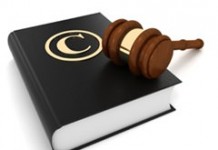I am not a lawyer. But every time I reach a point in my understanding of copyright law where I feel as though I finally understand it, something comes up that makes it clear I don’t know nuthing.

When did this feeling of helpless incomprehensibility first come about? It was probably when I realized that Americans will be traveling in space elevators before they can legally post an mp3 of Andrew Sister’s Bei Mir Bist du Schon (1937) on a website. (Current estimates are that we may even have space elevators before it will be legal to sing the 1893 song Happy Birthday in public). I guess we will have to consult Lawrence Lessig or William Patry about the legality of singing the Warner-Chappell song inside a U.S. built space elevator.
But another legal can of worms involves the use of images for Wikipedia (and its sister projects). It has implications that reach far beyond U.S. borders.
After much reading and researching, I reached the happy conclusion that the Berne Convention caused all images by artists who had died 70 years ago to go to the public domain. Also, under the U.S. court decision of Corel vs. Bridgeman, it is legal for people to copy/steal any image of a public domain painting if it is a faithful reproduction. Think about it: if it were possible to copyright an image merely by being the first person to take a photograph of it, artists could lose control over their creations unless they were the first ones to publish a photograph of it). Therefore, I concluded, if the artist died in 1937 or before, then photographs or scans of ANY image created by an artist who died more than 70 years ago belongs to the public domain irrespective of when the photograph was taken. (See endnote 1).
Wikipedia’s explanation/interpretation of this rule established this in a fairly authoritative way. Or so I thought. Apparently in the last month the Wikipedia public domain page has been updated to correct the mistaken information it had previously.
Before I say anything else, let me say that most signers to the Berne treaty don’t have the copyright problem I am about to spell out: only the U.S. does.
In the U.S., a painting is automatically in the public domain if the artist died 70 years ago EXCEPT where the art/painting was published between 1978-2003, but not earlier. If first publication occurred between 1978-2003 (and not prior to that), then the painting won’t belong to the public domain in the U.S. until 2047. See this discussion (See also endnote 2 about what constitutes “publication”).
Basically you need to verify that a painting was photographed or reprinted in an artbook prior to 1978. Do you know how difficult it is to look up whether a painting was printed/reprinted in a book before 1978? Yes, it’s possible to check the renewal/first publication dates of literary works, but not illustrations within them. (Google Book Search might help).
It grows more complicated. Apparently, the Berne Convention contains a part called Rule of the Shorter Term which the US Congress seems not to have adopted (read an introduction here). This provision determines whether a country’s laws can supersede the Berne Convention treaty for works published outside the country. Basically it said that a country cannot prolong copyright longer than what it is in the country where it was first published. But that is precisely what U.S. copyright has done for works first published between 1978-2003. Some within the wikipedia community say that Congress’s explicit denunication of Shorter Term rule was no longer relevant because it applied to an earlier version of the Rule of the Shorter Term. Other disagree.
In any event, the failure of the US to adopt this rule has profound implications on the Wikipedia project. Because Wikipedia servers are hosted in Florida, they have to follow the rule as interpreted by the United States. As a result, a lot of images and texts (but especially images) are unavailable to Wikipedia (or its sister sites like Wikipedia, Wiktionary, Wikibooks, Wikinews, Wikiquote, Wikisource, Wikiversity, and Wikimedia Commons) even though they are available in just about every other place in the Western world. Wikipedia editors around the world are predictably outraged and have even started a petition to US Congress to protest it. Why should their ability to view and produce content legal in their own country be dependent on what the U.S. deems permissible?
Here’s a commentary on the meta-wiki:
With American non-acceptance of the rule of the shorter term, users of Wikimedia sites have to determine if a work, especially an image, is legally copyrighted in the USA even if it is in the public domain in the country or area where they are from. In case a work is legally copyrighted in the USA even if the owners of the restored USA copyright cannot be readily contacted, claiming fair use pursuant to 17 U.S.C. 107 may be possible at some but not all Wiki sites. Should a work be legally copyrighted in the USA without valid fair use claim, administrators may have to reluctantly delete it. As some users outside the USA may not be aware of the American non-acceptance of the rule of the shorter term, such a problem would increase the burden of administrators and impede the development of Wiki sites.
To summarize: not only do Americans need to deal with the rigmarole of having to check whether orphaned works are registered with the U.S. copyright office, so do all wikipedia producers overseas!
Now it’s prediction time. Which event is more likely to happen first: U.S. Congress will pass a law accepting the Shorter Term rule, or Wikipedia will start hosting its content in a country with more mainstream copyright laws?
Update: See also this report about last week’s Golan vs. Gonzales copyright decision, and read my comment below about how it may affect the usage of images.
Update #2 (June 11, 2008). I’m going to revise my previous statement. The key question is whether the work was in the public domain in its home country on 1 January 1996. If yes, then it is in the public domain in US, but only if the Rule of the Shorter Term applies in the US. Currently as of June 2008, the Rule of the Shorter Term is not valid in the US (but there is a significant constitutional challenge to it in Golan vs. Gonzales). Note: the Corel principle that photographs of paintings are copyrightable applies only within the US, not other countries. Also, this exception doesn’t apply if the foreign publisher went ahead and published it in the US within 30 days after publishing it in the home country. Optimistically speaking, this would suggest that images published by someone who died in a Berne-adopting country 70 years before 1 January 1996 would be in the US public domain if Golan took effect (causing the Rule of the Shorter Term to apply). A simpler rule might be: if an image has been published on Wikipedia or Wikimedia Commons and it’s been there awhile, it’s probably public domain in the US. In fact, I’ve noticed that the Wiki empire is using copyright tags to indicate which kind of public domain status would apply. Ideally, people would tag what they know would be correct, with some images receiving one or more tags when appropriate.
Update #3 (June 11, 2008): Here is a carefully-worded statement by Wikipedia on public domain expiration:
All copyrights and patents have always had a finite term, though the terms for copyrights and patents differ. When terms expire, the work or invention is released into public domain. In most countries, the term for patents is 20 years. A trademark registration may be renewed and remain in force indefinitely provided the trademark is used, but could otherwise become generic.
Copyrights are more complex than patents; generally, in current law, the copyright in a published work expires in all countries (except Colombia, Côte d’Ivoire, Guatemala, Honduras, Mexico, Samoa, and Saint Vincent and the Grenadines) when either of the following conditions are satisfied:[5]
* The work was created and first published before January 1, 1923, or at least 95 years before January 1 of the current year, whichever is later; or
* The last surviving author died at least 70 years before January 1 of the current yearbut only provided that both of the following also hold:
* No Berne Convention signatory has passed a perpetual copyright on the work; and
* Neither the United States nor the European Union has passed a copyright term extension since these conditions were last updated. (This must be a condition because the exact numbers in the other conditions depend on the state of the law at any given moment.)These conditions are based on the intersection of United States and European Union copyright law, which most other Berne Convention signatories recognize. Note that copyright term extension under U.S. tradition usually does not restore copyright to public domain works (hence the 1923 date), but European tradition does because the EU harmonization was based on the copyright term in Germany, which had already been extended to life plus 70.
Who knows if this is just a temporary “wikitruth” or a more durable statement about copyright? On the other hand, description of these rules and policies about public domain images are vital to wikipedia’s existence, so I suspect they are vetted very carefully.
Update #4 (June 12, 2008) : I wonder: when/if Golan is overturned, would that liberate any published foreign works which were not in the public domain as of 1996 but fell into the public domain in foreign countries later on? For example, if a German artist died in 1937, his works would be in the public domain in Germany; would that mean that it also would be in the US as well? Or would it simply apply to the narrow segment of works which briefly went in the public domain in 1989 (when the US adopted the Berne Convention) and then disappeared from the public domain in 1996 (when we passed the Uruguay Round Law).I have no idea.
Update #5 (June 12, 2008): The key thing to remember is if only one photograph of an image is published in a foreign country and is considered public domain here, then all photographs of that image published in the US will be put in the public domain (according to Corel).
Update #6 June 27, 2009. I just recently learned that a federal judge agreed in Gonzales v. Holder that works put in the public domain before Uruguay Round Law placed them back into copyright.. This suggests to me that the Rule of the Shorter Term is essentially in force. Time will tell if this sneaky suspicion becomes a joyous reality.
Update #7 July 6 2010 . Whoops, it looks like a federal appeals court overruled the lower court’s decision about Golan. This latest decision ruled that the Uruguay Rule of the Shorter Term (that put some foreign-produced works in the US public domain back under copyright) was valid. Therefore, Uruguay Round still applies, and those foreign-produced works which were previously in US legal limbo are now safely in US copyright again. Terrible news, and let’s hope the Supreme Court decides to take it. In the meantime, Public Domain Sherpa has a chart which illustrates the complexity of works published overseas. (The famous Hirtle copyright reference chart has not been updated). Wikipedia’s image use templates have been updated accordingly.
Update #8. April 9, 2011. Shazbot! The US Supreme Court has decided to take the case, and we will have a definite answer soon (hopefully). Looking over what I wrote and this interesting article by lawyer Kevin Smith, it appears that the primary scope of the case is limited to works first published overseas, copyrighted in the US and then never renewed in the US but still in copyright overseas. I have to admit that the US law restoring copyright for works belonging to this category to comply with the Uruguay Round has the advantage of consistency and simplicity. Unfortunately, it is at the expense of our expectation that works in the US public domain should stay that way. My guess is that the Supreme Court will simply reaffirm the decision of the lower courts, but it would be nice if the Supreme Court takes a stand on the public domain sometime. Regardless, I predict some interesting pronouncements of the role of public domain in the USA. Two related things: First, this case could have an impact on the Google Books settlement and see Hirtle’s fascinating 2008 article about how Golan will make it hard to figure out if foreign works go into the public domain. See also this interesting article by law professor Edward Lee on the social effects of Golan:
Among the thousands of works affected, copyright restoration removed numerous works of Shostakovich, Prokofiev, Stravinsky and other composers from the public domain. Kapp, Golan and other educators had to stop using and teaching the formerly public domain works. Use of the works is now subject to copyright and is, in many cases, cost-prohibitive. In a survey conducted by The Conductors Guild, 70% of orchestral conductors polled stated that, because of copyright restoration, they had to forego performing works that used to be in the public domain, but are now subject to restored copyrights. Even derivative works — meaning new works derived from old works — are harmed by this law. Kapp’s own recordings of his arrangement of Shostakovich’s String Quartets were suddenly saddled with a restored copyright owned by someone else — which destroyed the investment and financial calculus Kapp originally made in the recordings. Because of copyright restoration, Kapp was supposed to pay to sell what he thought was royalty-free.
The secondary effects of this harm impacts students and the American public, who have lost the opportunity to learn and enjoy many works of great cultural importance. By recopyrighting Prokofiev’s Peter and the Wolf, for example, generations of our children no longer hear its public performance because copyright has put the music out of reach for most orchestras. Copyright holders don’t sell the sheet music to classical works; instead, they rent the music for each performance at prices — often in the neighborhood of a thousand dollars or more — that many orchestras and ensembles simply cannot afford. When many orchestras around the country are going bankrupt, the unexpected costs imposed by recopyrighting works in the public domain come at a very inopportune time.
* * * *
Notes
1. As the wikipedia entry for the case states, because the case wasn’t appealed or cited in succeeding cases, its authority as a precedence is unclear (it should be pointed out that Creative Commons or GPL hasn’t been tested in court either). Yet, it seems to conform with general understanding about copyright and hasn’t been overruled.
2. (There is a side issue about what constitutes “publication” for a painting. The public domain page says:
Because an artwork is not published by being exhibited, and also neither by being created or sold, one needs to know when reproductions of the artwork (photos, postcards, lithographies, casts of statues, and so on) were first published. That constitutes publication of the artwork, and from then on, the work is subject to all the rules for published works.
For most artworks, a year is usually given, but this is normally the year the work was made, not the year it was published. Figuring out whether and if so when a particular painting was published can be difficult).


































Robert Nagle says of the Berne Convention:
“Basically it said that a country cannot prolong copyright longer than what it is in the country where it was first published. ”
No, it simply says that that’s the default assumption, if the country’s laws don’t say otherwise. Note the “unless the legislation of that country otherwise provides” language. It’s not a requirement that countries adopt the rule of the shorter term; it’s simply an allowed exception to Berne and local term minimums, and effectively an incentive to get other countries to increase their terms to match those of other countries. (Repeatedly and reciprocally, if necessary, which we’re seeing the deleterious effects of now.)
There are lots of countries besides the US that don’t use the rule of the shorter term for at least some works of foreign origin. Canada, for instance, doesn’t use it for US works.
Also, I don’t see how you come to the conclusion (or, for that matter, where the WP discussion comes to the conclusion) that the life+70 rules apply in the US for pre-1978 image publications. As far as I’m aware, for instance, if an image was first published and copyright secured for it in 1965, it gets a 95-year term in the US, not a life+70 term.
But I’m not a lawyer either. Someone who *is* a lawyer and has written a book about public domain status is Stephen Fishman; those who want expert opinions on these matters might want to check out his book _The Public Domain_ (Nolo Press). It includes chapters on how the public domain works for images and the like.
I admit, it is VERY confusing (and by the way, I fully expected someone with a keener mind to point out some subtle but devastating error in my article here). I think you may be the one!
I think the question depends on whether a painting was first published abroad or in US and whether it was in the public domain in the home country as of 1996.
I’m looking at Hirtle’s copyright chart . Pay particular attention to the section marked “Works Published Abroad Before 1978 Without Compliance with US Formalities” :
1923 through 1977 (Works Published Abroad Before 1978 Without Compliance with US Formalities): If a work is in the public domain in its home country as of 1 January 1996, it’s Death +70.
A lot of foreign-published works were considered public domain in the US because they didn’t comply with US formalities.
The U.S. originally considered these foreign-published works in the public domain, but the Uruguay Round Agreements Act restored copyright protection on these works until 2047 (more or less). That is why Golan vs. Gonzales (which challenged Uruguay Round Agreements Act passed by the US) copyright to these US public domain works) seems like such a big deal.
In retrospect, it probably was a mistake for me to split the report about Golan vs. Gonzales with this one about wikipedia/images because they seem so interrelated.
As I see it, Bridgeman v Corel says that if you have just a single instance of a published photograph of a painting in the public domain in the US, then by implication all photographs of that painting are considered public domain in the U.S. as well. I could be wrong here (and Bridgeman is not a very sturdy precedent yet). So if a painting were in the public domain in France as of 1996, then any photograph of that painting would also go into the public domain in the US. (Now I don’t know about the state of public domain in EU countries in 1996). The reason I am pointing to foreign-produced works so much is that it is easier to figure out when copyright protection ends (it’s Death + 70). In the U.S. it is too difficult to make this determination (because you would need to locate a specific publication that gives you a basis for claiming public domain).
As far as whether Rule of the Shorter Term still applies, some at Wikipedia have said that the US explicit rejection of the Rule of the Shorter Term doesn’t exply because of Uruguay. Here’s the wikipedia commentary on the Shorter Term rule :
Finally, I should mention my ambivalence about citing Wikipedia articles when talking about copyright law in the US. On the one hand, the issues are of vital importance to Wikipedia, so I would expect the organization to give these articles a significantly higher level of scrutiny than it would for a page about a celebrity. On the other hand, this is Wikipedia we’re talking about, and it’s not terribly hard to insert a wacky interpretation here and there.
By the way, because I fear my semi-informed pronouncements have misled too many readers already, I will refrain from making further comments here and let commenters enlighten us (In the meantime, I am booking my space elevator reservations today).
[…] I revised the first part of this article substantially for my teleread article. It deals with copyright, public domain image and Wikipedia. Below is the second part of this article which is on a smaller but no less important point). […]
HI I’m confused, when i look at art reproduction companies, some will only reproduce art prior to 1937 stating the 70 year copyright law. Others say that in all EU countries, copyright lasts for 70 years but for countries outside the EU it is 50 years. Is this true, can people legally reproduce art by Kandinsky then?
The Wikipedia people are idiots. They offend Muslims by leaving up a picture of Muhammad, then come up with ticky-tacky excuses of why you cannot upload a picture you took yourself because some corporate logo or other is in the frame.
Sod off, Wiki-bamas!
I’m going to answer one of John Mark Ockerbloom’s points. He wrote:
The key question is whether at least one copy of the image has ever made it in the public domain overseas. If it has, and if American copyright has to respect this public domain determination, then according to Corel (an American precedent, mind you), pretty much all photographs of that same image would have to be considered public domain in the US. I don’t care whether an American-published book of a German painter is still under copyright. I care whether a image of a painting by a German who died in 1937 was published originally in Germany. If it was, then it would go into the public domain in Germany. If Golan applied for works which went into the public domain in another country after 1996, would that imply that all versions of that same image would flip into the public domain in the US? I honestly have no idea if this applies to works published overseas which flipped to the public domain after 1996.
April 2011 Update. I think my understanding of the issues on this comment is wrong. The issue of Golan concerns works which made it into the public domain in the US but are still in copyright abroad. It is doubtful that works in Boerne countries will go into public domain before they did in the US.
[…] Update June, 2008: My most recent understanding is reflected on this teleread article I wrote about Wikipedia, images and copyright […]
[…] other words, this affects the Rule of the Shorter Term provision (which I wrote about several years ago). Rule of the shorter term requires countries to honor the public domain status of a work if it is […]
[…] court upheld the copyright ruling that upheld the Rule of the Shorter Term. I have updated my Is US Copyright Law hurting Wikipedia? article with this statement: It looks like a federal appeals court overruled the lower […]